AVC Technology F024 Digital Audio Flash Player User Manual DFP4000 Manual FCC
AVC Technology Limited Digital Audio Flash Player DFP4000 Manual FCC
User Manual
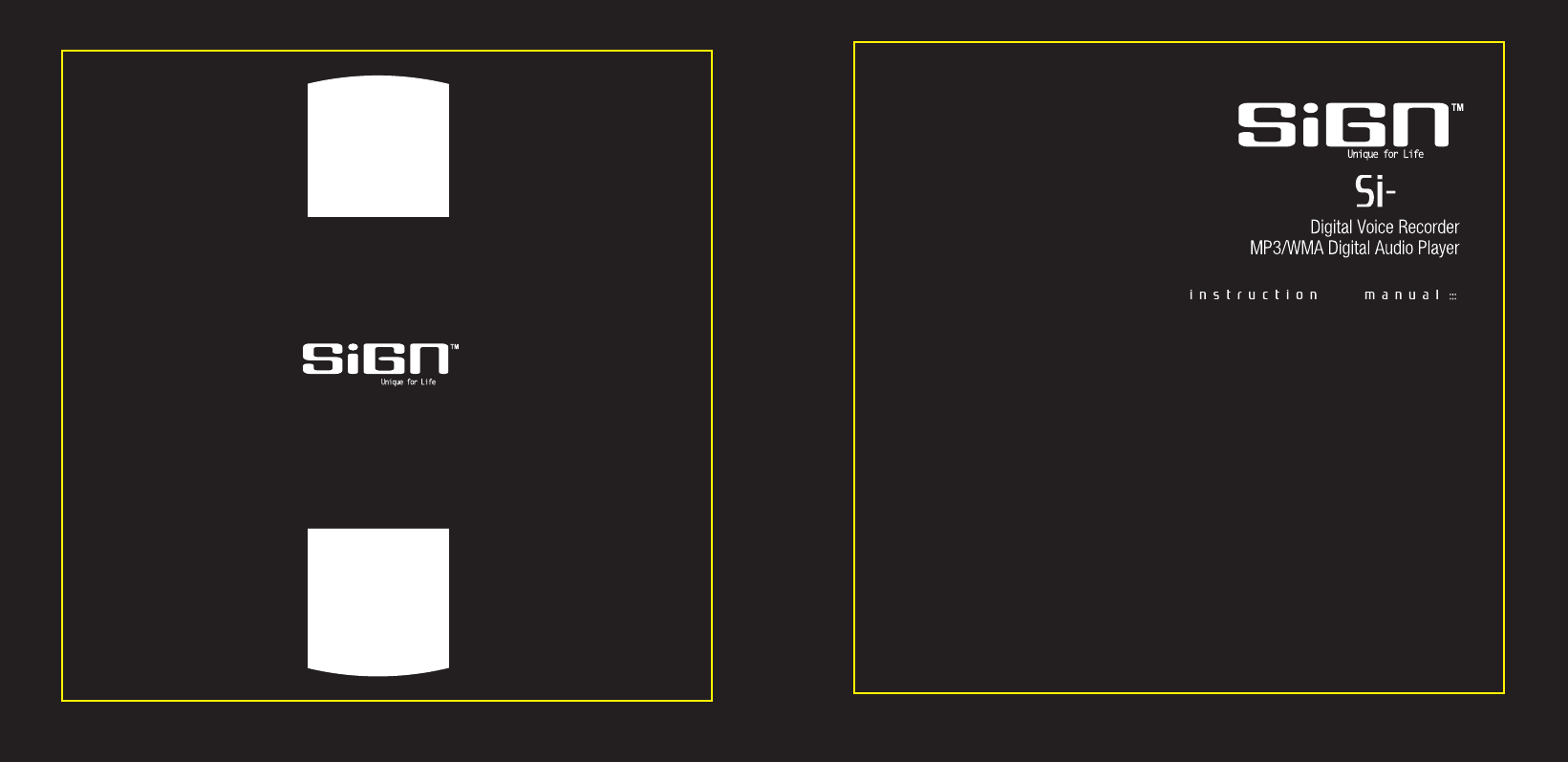
120120

Brief Introduction
INTRODUCTION -- DIGITAL AUDIO PLAYER (DAP) – Si-120
Selecting fine audio equipment such as the unit you have just purchased is only the start of your musical
enjoyment. Now it is time to consider how you can maximize the fun and excitement your equipment
offers. This manual provides detailed operation instructions and features of the unit. Please read this
manual carefully before using this product for the first time.
KEY FEATURES
Multi-format player supports: MP3, WMA, WMA with DRM and WAV files.
USB 1.1 data transfer.
Windows Plug & Play support for Windows XP, 2000 and ME.
Windows 98SE compatible: Driver required.
Built in FM tuner with auto scan and preset up to 20 stations.
Line-in Encoding function
Voice recording and FM tuner records FM radio programs.
Ten preset Equalizer Modes with User Defined EQ.
Dual color OLED for displaying information.
Power saving feature with Screensaver.
Voice Activation Detection
SRS WOW Sound Enhancement
Battery level indication.
Support multi-languages.
Supports long file name.
Firmware Upgradeable
Update the latest features via free download from the website:
www.signstyles.com
PACKAGE CONTENTS
The packaging should include the following accessories:
Digital Audio Player Stereo Earphones 1 x AAA Battery
Carrying Pouch Line-in Cable Installation CD-ROM
Neck Strap User Manual USB Cable
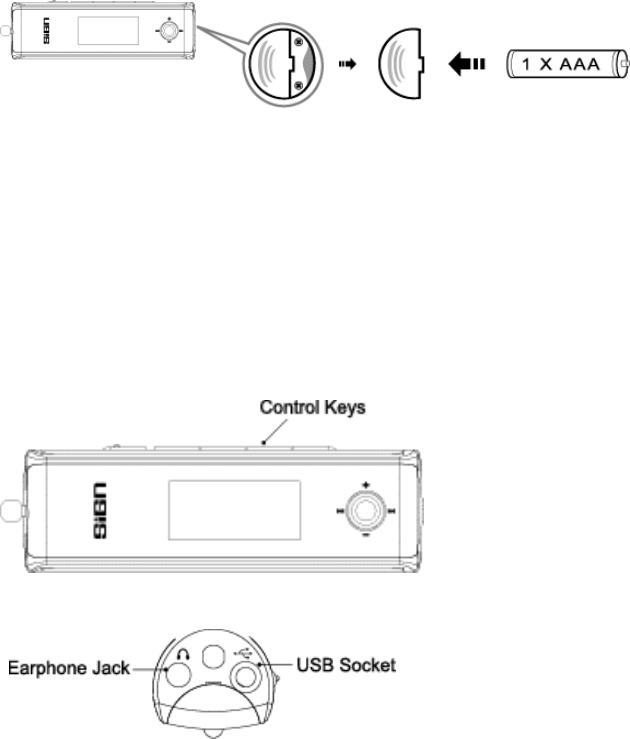
1
INSTALLING THE BATTERY
Push open the battery compartment door. Insert the 1 x AAA Alkaline battery with the
correct polarity as shown. Close the battery compartment door.
- To avoid battery leakage or corrosion, remove the battery from the player if the player is
not to be used for a long time.
- Remove dead battery from the player immediately to avoid damaging the player.
- When corrosion occurs, wipe the battery compartment immediately with a dry cloth and
insert a new battery.
PARTS DESCRIPTION
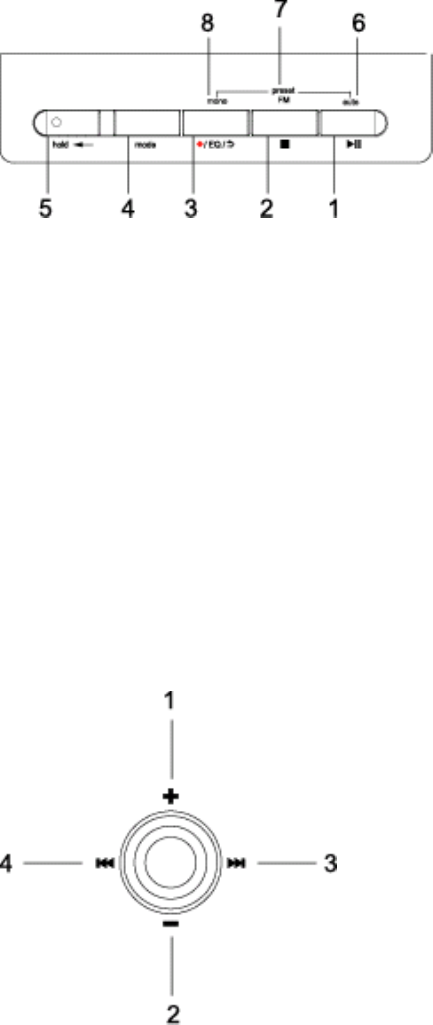
2
CONTROLS
Key Functions
1. Press to turn the player ON.
Press to play or pause music files.
2. Press to stop music files.
Press and hold to turn the player OFF.
3. Press to access into the Repeat mode.
Press and hold to access into the Equalizer mode.
Press to record FM tuner or voice.
4. Press to access into the Main Menu.
Press and hold to access into the Settings mode.
5. Slide to the left to lock all key functions.
Slide to the right to unlock all key functions.
6. Auto scan button (For FM Radio mode)
7. FM preset (For FM Radio mode)
8. Mono button (For FM Radio mode)
Key Functions
Press down to select.
1. Press to increase the volume.
Press and hold to increase the volume rapidly.
2. Press to decrease the volume.
Press and hold to decrease the volume rapidly.
3. Press to select the next file.
Press and hold to fast forward within the files.
4. Press to select the previous file.
Press and hold to fast rewind within the files.
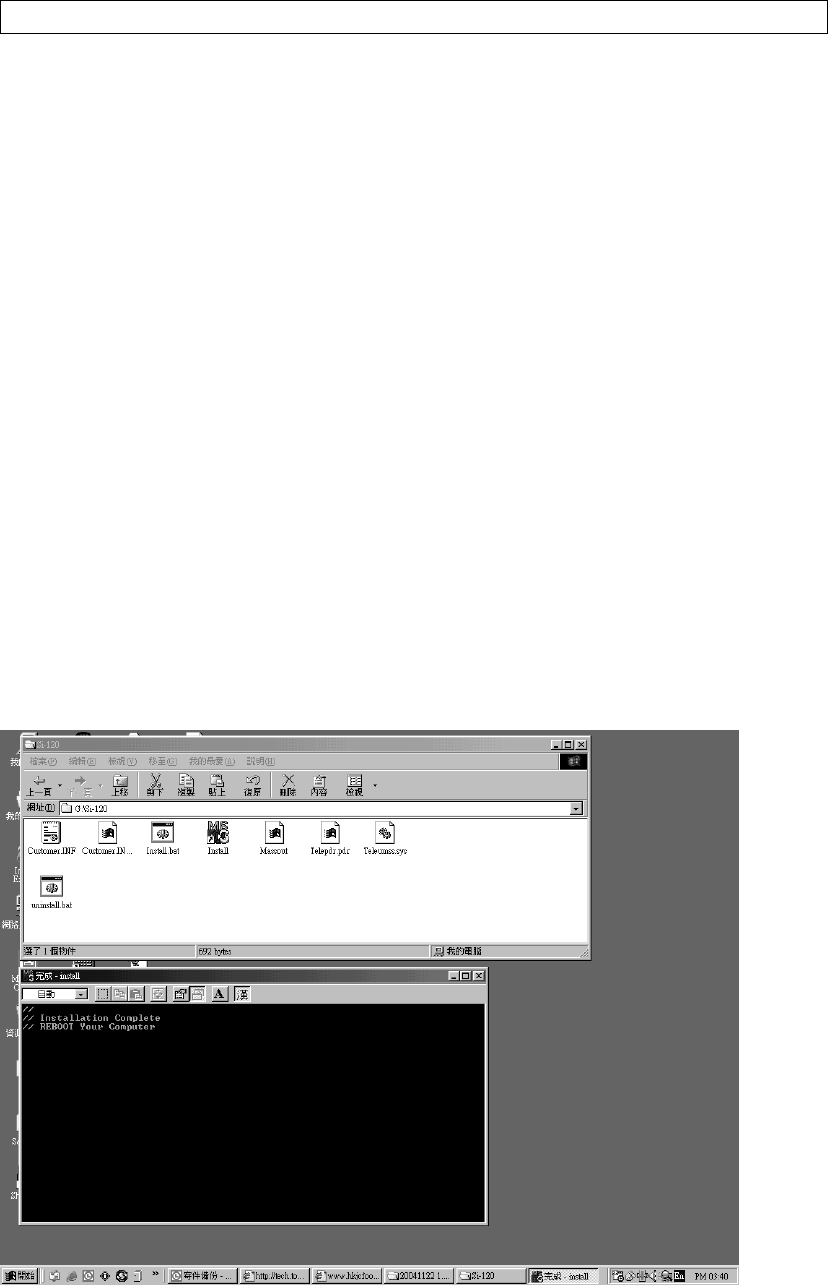
3
Downloading and Transferring Files
DRIVER INSTALLATION
For Windows ME, 2000, XP or MAC OS 10.2.8 or higher:
These versions of Windows will automatically detect your DAP after connecting with the USB
cable and the computer. (Please make sure the DAP is turned ON)
For Windows 98SE:
Windows 98SE will not recognize the player until you have installed the driver using the
included installation CD-ROM. Follow the detailed instructions in this section to activate the
USB mass storage function so you will be able to transfer files from your computer to your
player.
Installation Procedures for the Player Software (For Windows 98SE only)
When connecting the player to the computer for the first time, please follow these instructions:
1. Insert the CD-ROM into the CD Drive. Double Click “My Computer”. Then Double Click on
the “Si-120” CD-ROM drive directory.
2. Double Click the “Install.bat” file. The MS-Dos window will open up and indicate
“Installation Complete.”
3. Restart your computer before transferring files to your DAP.
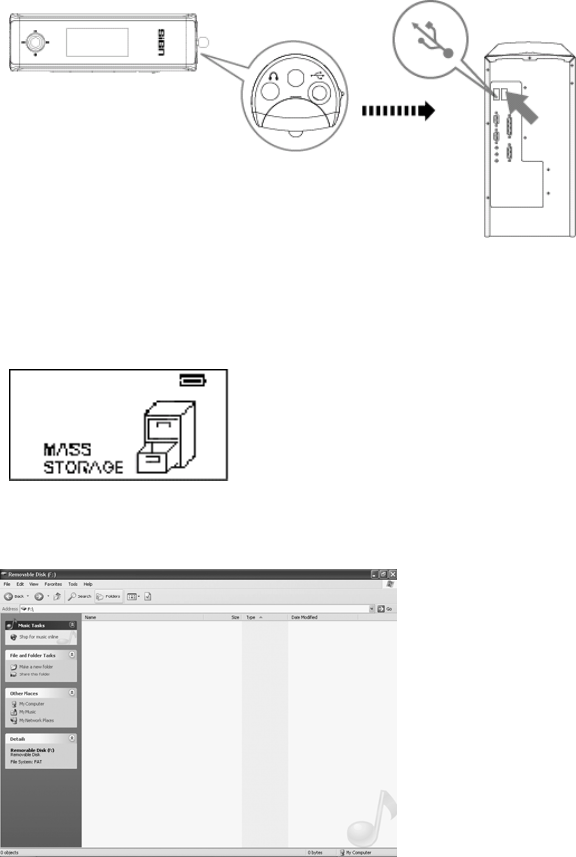
4
TRANSFERRING FILES
1. Connect the DAP to the computer by using the supplied USB cable.
2. The following will be displayed on the screen of your DAP player:
3. A “Removable Disk” will be added in “My Computer”. Open the “Removable Disk” folder:
Locate the files you wish to copy from the computer to your DAP. Drag and drop MP3, WMA
or WAV files on the computer into the “Removable Disk” folder. These files will now be copied
into your DAP.
NOTE: When you have finished transferring files, use the “Safely Remove Hardware
Procedure” before disconnecting your player. (Please see the next section for detailed
instructions.)
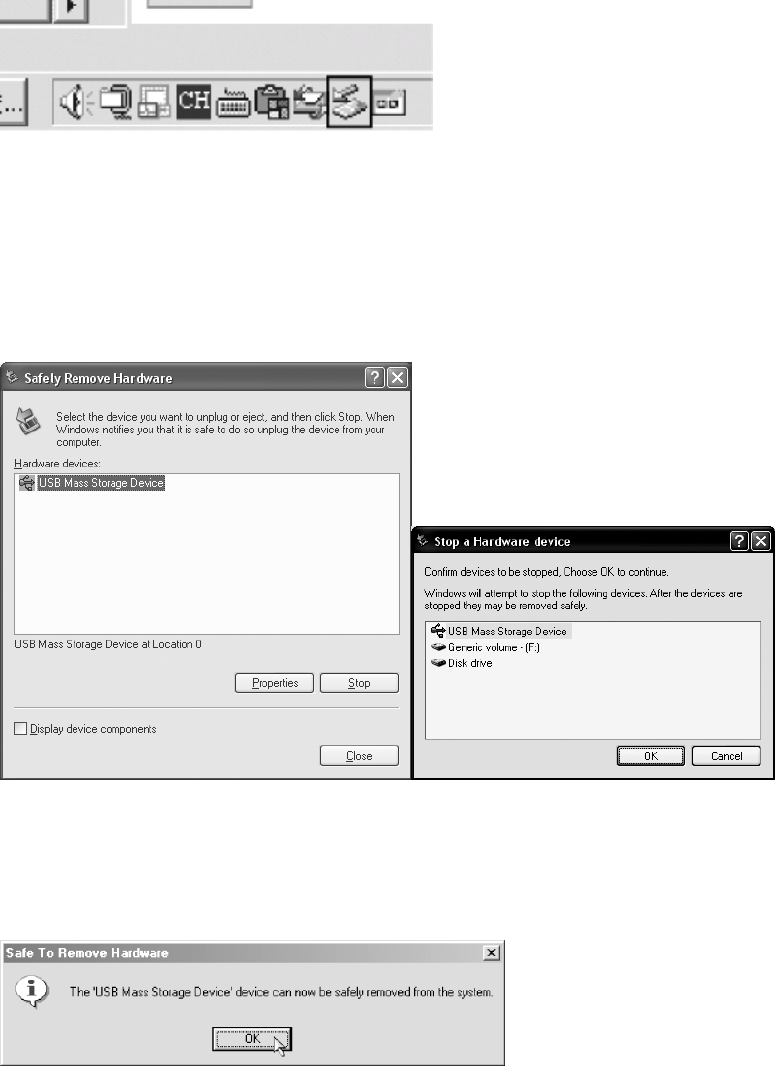
5
SAFELY REMOVE HARDWARE PROCEDURE
1. Double click the “Safely Remove Hardware” icon on the task bar:
2. From the “Safely Remove Hardware” window, select “USB Mass Storage Device” and click
the “Stop” button. The “Stop a Hardware Device” window will pop up as shown:
3. Click “OK”. A “Safe to Remove Hardware” window will pop up. Now, it is safe to remove
the USB Cable and your DAP player from the computer.
Remarks: If the “Safely Remove Hardware” icon is not displayed on the task bar, please
double click on “My Computer”. Right click on “Removable Disk”, then left click on “eject”.
Now it is safe to remove your DAP from the computer.
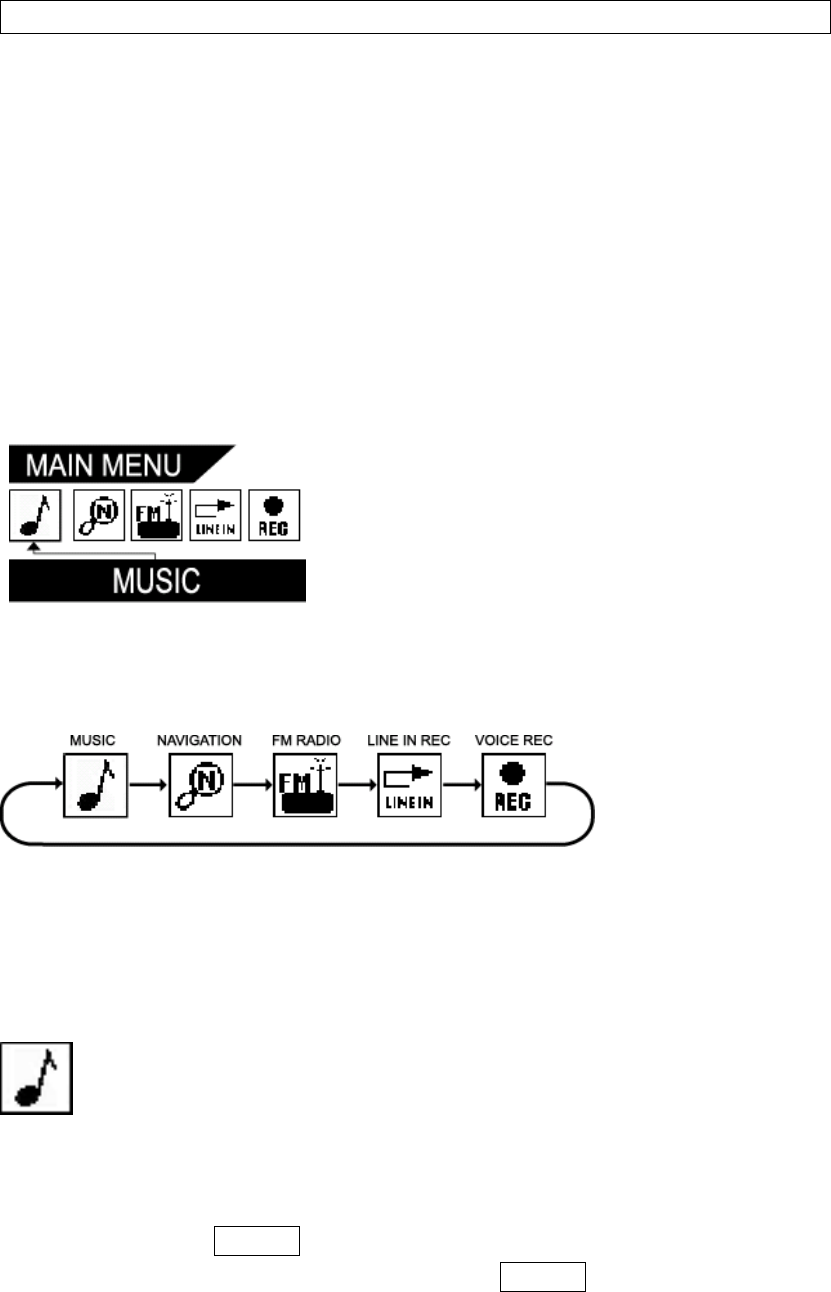
6
OPERATION
LISTENING TO MUSIC
After you have transferred MP3, WMA or WAV files from the computer to your DAP, you can
start listening to music while you learn how to use the rest of the features.
Insert the earphones into the earphone jack of the player; press the XII button to turn the
player ON.
USING THE MAIN MENU
Press the mode button to access the MAIN MENU. The following menu will be displayed
on the screen:
Press the or the button until your desired selection is highlighted and press the
XII button to confirm the selection.
MUSIC PLAYER
To listen to any files or songs stored in your DAP Player, you can select the MUSIC PLAYER
mode.
Using Special Functions
Changing the EQ mode
- Press and hold the /EQ/2 button until the current mode is displayed in the lower
right hand corner of the display. Keep pressing the /EQ/2 button repeatedly to
select one of the twelve equalizer modes:
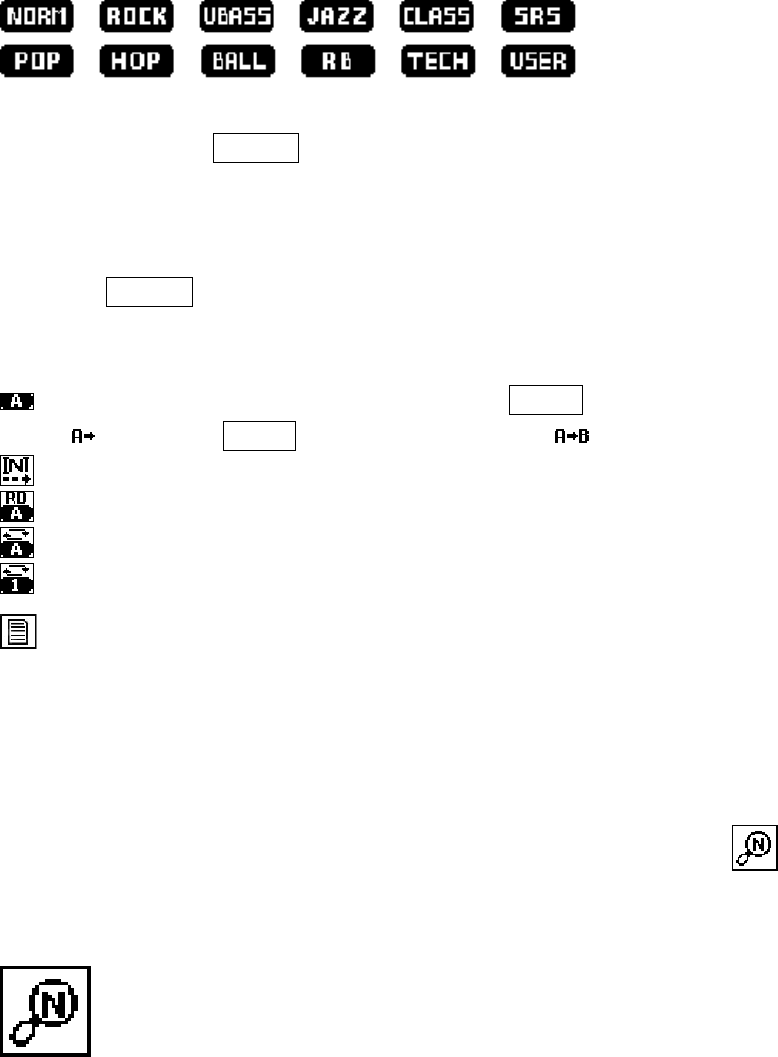
7
- Stop pressing the /EQ/2 button when your desired selection is displayed.
Repeat Button
Press the /EQ/2 button repeatedly to select different repeat mode options. As each
mode is selected, the following icons will be displayed on the upper right hand of the screen on
your player:
Edits and plays one section repeatedly. Press /Navi once to start with point A
and press /Navi again to end with point B .
Play the first ten seconds of each file.
Randomly play the files.
Play all the files repeatedly in consecutive order.
Play a single file repeatedly.
Plays the play list. (The play list must be created before using this function.)
NAVIGATION
You may search for, listen to, and program the play list in the NAVIGATION mode. Press the
mode button and use the or the button to highlight the Navigation
icon as shown.
Press the XII button to confirm and access in the Navigation menu.
All the files are displayed in the Root/ folder. FM recorded files are stored in the Radio/ folder
and voice recorded files are stored in the Voice/ folder. Press + or the - button to
scroll through the files. Press the or the button to access in and out of the
folders.

8
Creating a play list from the DAP
- Enter into the Navigation menu.
- Press the + or the - button to highlight a desired song or file.
- Press the /EQ/2 button; a number icon (01, 02 etc.) will be displayed next to that
song or file.
- Press the /EQ/2 button to confirm the song or file selection; the number icon will
disappear and the file or the song will be added to the play list.
- Follow these steps with each file you would like to add to your play list.
NOTE: The play list cannot be created during file playback.
Deletion
- Enter into the Navigation menu.
- Press the + or the - button to highlight a desired song or file.
- Press the button; a [FILE DELETE] YES/NO box will display.
- Press the or the to select between Yes and No.
- Press the /Navi button to confirm the selection.
NOTE: Files cannot be deleted during playback.
Certain files can only be deleted through the computer.
FM RADIO
The DAP has a built-in FM tuner with auto scan and twenty preset station memory. Besides
listening to your favorite station, you can also record a song or program.
Press the mode button and use the or the button to highlight the FM Radio
as shown:
Press the XII button to confirm the FM Radio mode.
Setting FM Stations with Auto Scan
- If Preset is displayed in the screen, press the button to clear it.
- Press and hold the XII button to begin auto scan. “FM Search” will be displayed on
the screen. Each detected FM station will be stored in memory with a channel number icon
from [Ch01] up to [Ch20] next to the station frequency.

9
NOTE: Each time auto scan is performed the previously preset channels will be
overwritten by the new FM stations detected.
Setting FM Stations Manually
- If the “Preset” icon is displayed in the screen, press the button to clear it.
- Press the button to increase the FM frequency. To fast forward scan, press and hold
the button. The unit will stop at each FM Station detected.
- Press the button to decrease the FM frequency. To fast rewind scan, press and
hold the button. The unit will stop at each FM Station detected.
- To store each station into memory, press the XII button. “Memory” will be displayed.
- To select a different channel number, use the or the button.
- Press the XII button to store this FM frequency in the selected channel number.
(“Memory” will clear from the screen.)
Using the Preset Channel
- Press the button to display “Preset”.
- Use the button to select the next preset station and use the button to select
the previous preset station.
Recording a FM Radio Station
- Press the /EQ/2 button to start recording.
- Press the XII button to pause and unpause recording.
- Press the button to stop recording.
NOTE: The volume is not controlled during recording.
Line-in Encoding
Press the mode button and use the or the button to highlight the Line-in icon
as shown.
Press the XII button to confirm and enter the Line-in mode.
- Use the supplied Line-in cable to connect your DAP with the Audio out jack of another
audio player such as a CD player.
- Press the /EQ/2 button to start recording. Then play the desired track from the other
source.
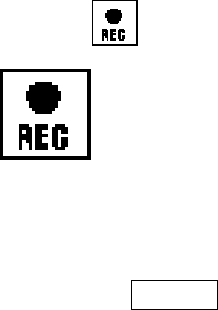
10
- Press the XII button to pause and unpause recording.
- Press the button to stop recording.
Listening to the Encoded File
- Enter into the Navigation mode to locate the newly encoded file. The file will be saved in
the “LINEIN” Folder
- You may change the file name of the file through your computer in order to match the artist
and song title.
RECORDING
Use your DAP to record quick reminder memos or even lengthy business meetings or lectures.
Press the mode button and use the or the button to highlight the Voice
Recorder icon as shown.
Press the XII button to confirm and enter the Voice Recorder mode.
Recording voice with the Microphone
- Press the /EQ/2 button to start recording.
- Press the XII button to pause and unpause recording.
- Press the button to stop recording.
Listening to the Recorded File
- Search and highlight the recorded file in the Voice Folder of the Navigation Mode.
- Press XII to start playback of the file.
NOTE: The volume is not controlled during recording.
You may select four different quality levels for recording through the settings
as described in the next section.
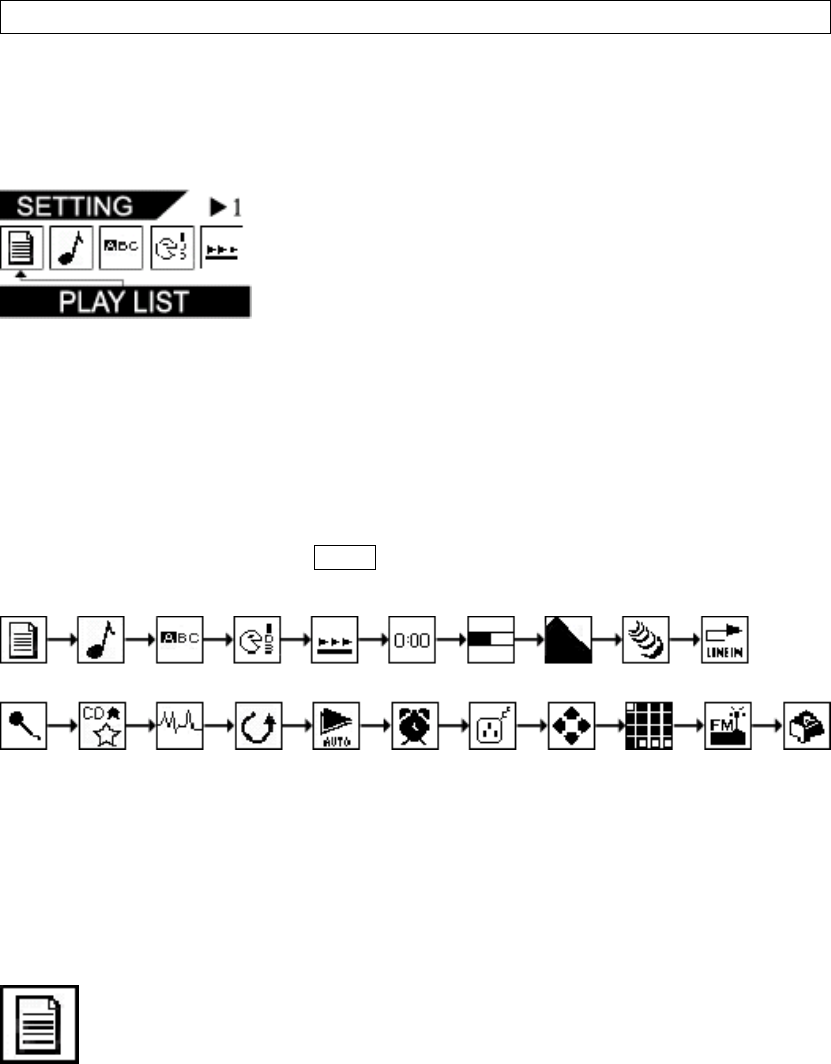
11
CUSTOMIZING THE PLAYER
USING THE SETTING MENU
The Setting Menu provides the options to change the player settings.
Press and hold the mode button to display the SETTING menu on the screen.
Press the or the button to select one of the following setting options: Play List,
Equalizer, Menu Language, ID3 Language, Scroll Speed, Play Timer, Brightness,
Screensaver, Voice B/R, Line in B/R, MIC VAD, CD Sync, Play Speed, Resume, Autoplay,
Sleep, Auto Power Off, Load Default, Format, FM Band, or About me. Once your selection is
highlighted then press the XII button to confirm. Press the or the button to
highlight a new setting. Press the /Navi to choose a new setting.
To exit the SETTING Menu, press the + button.
Setting Features
Play List Setting
Press the + or the - button to select the desired file.
Press the XII button to play the play list.
Or Press and hold the button to clear the list.
Press the button to exit
NOTE: If you have deleted or not programmed a play list, “00” will be displayed on the
Screen.

12
Equalizer Setting
Press the or the button to choose from the preset EQ modes or User Defined EQ.
Press the /Navi button to confirm the Sound mode.
Menu Language Setting
Press the or the button to select one of the languages for the user interface.
Press the /Navi XII button to confirm the language selection.
ID3 Language Setting:
Press the or the button to select one of the languages for the file names.
Press the /Navi button to confirm the language selection.
Scroll Speed Setting:
Press the or the button to select the speed of the text scrolling on the display.
Press the /Navi button to confirm the language selection.
Play Timer Setting
Press the or the button to select between ELAPSED TIME and REMAINING TIME.
Press the /Navi button to confirm the play timer selection.

13
Brightness Setting
Press the or the button to adjust the Display brightness level.
Press XII button to confirm the brightness level.
Screensaver Setting
Press the or the button to select the time before the screensaver is activated.
Press the /Navi button to confirm the timer selection.
NOTE: The battery life will be longest on the 10 sec setting.
Voice B/R Setting
Press the or the button to select one of the options for the four voice recording bit
rates.
Press /Navi button to confirm the selection.
Line in B/R Setting
Press the or the button to select one of the options for the three line in encoding bit
rates.
Press /Navi button to confirm the selection.
Mic VAD Setting
Press the or the button to select Microphone Voice Activation Detection. This
function will activate the voice recording when sound is detected.
Press /Navi button to confirm the selection.

14
CD Sync Setting
Press the or the button to select the CD Sync timer. Choose the number of
seconds of silence required for the Line In Encoding function to separate different tracks.
Press /Navi button to confirm the selection.
Play Speed Setting
Press the or the button to select the speed of the file playback.
Press /Navi button to confirm the selection.
Resume Setting
Press the or the button to select between Resume On andf Resume Off. For
Resume On, at startup unit will playback at same point when unit was turned off. For
Resume Off, at startup unit will playback from first song.
Press /Navi button to confirm the selection.
Autoplay Setting
Press the or the button to choose from Autoplay On or Off. For Autoplay On,
playback will begin as soon as the unit is turned ON. For Autoplay OFF, the XII button
must be pressed after turning the unit ON to commence playback.
Sleep Setting
Press or the button to select an amount of time before the unit will shut off, so that
you may fall asleep while listening to your unit.

15
Press /Navi button to confirm the selection.
Auto Power Off Setting
Press or the button to select an amount of time before the unit will shut off while in
standby mode.
Press /Navi button to confirm the selection.
Load Default Setting
Press or the to select Yes in order to restore the units original settings.
Press /Navi button to confirm the selection.
Format Setting
Press or the to select between Normal or Quick format.
Press /Navi button to confirm the selection.
NOTE: Files will be deleted during formatting.
FM Band Setting
Press or the to select between International or Japan FM bandwidth setting.
Press /Navi button to confirm the selection.
About Me Setting
Enter to view the available memory and firmware version.

16
Additional Information
PRECAUTIONS
Copyright
Making copies of MP3 tracks or files without permission is a violation of the international
copyright laws.
Safety
Vibration experienced during walking or exercising will not affect the player. However,
dropping the player or dropping a heavy object on the player may result in damage or
sound distortion.
Avoid spilling any liquid onto or into the player.
Do not leave the player in a location near extreme heat sources or in a car with the
windows closed during excessive heat. Do not leave in a place subject to direct sunlight,
excessive dust or sand, moisture, or rain.
On Headphones and Earphones
Road Safety
Do not use the headphones/earphones while driving, cycling, or operating any
motorized vehicle. It may create a traffic hazard and is illegal in some areas. It
can also be potentially dangerous to play your headsets at high volume while
walking, especially at pedestrian crossing and potentially hazardous situations.
Preventing Hearing Damage
Avoid using the headphones/earphones at high volume. Hearing experts advise
not to play loud music for a long period of time. If you do experience ringing in your
ears, reduce the volume or discontinue use.
Consideration for Others
Keep the volume at a moderate level. This allows you to hear the sound and still
be considerate to the people around you.
17
FCC Warning
This device complies with Part 15 of the FCC Rules. Operation is subject to the
following two conditions: (1) This device may not cause harmful interference, and (2)
This device must accept any interference received, including interference that may
cause undesired operation.
Warning: Changes or modifications to this unit not expressly approved by the party
responsible for compliance could void the user's authority to operate the equipment.
NOTE: This equipment has been tested and found to comply with the limits for a
Class B digital device, pursuant to Part 15 of the FCC Rules. These limits are
designed to provide reasonable protection against harmful interference in a residential
installation. This equipment generates, uses and can radiate radio frequency energy
and, if not installed and used in accordance with the instructions, may cause harmful
interference to radio communications.
However, there is no guarantee that interference will not occur in a particular
installation. If this equipment does cause harmful interference to radio or television
reception, which can be determined by turning the equipment off and on, the user is
encouraged to try to correct the interference by one or more of the following
measures:
Reorient or relocate the receiving antenna.
Increase the separation between the equipment and receiver.
Connect the equipment into an outlet on a circuit different from that to which the
receiver is connected.
Consult the dealer or an experienced radio/TV technician for help.
Shield cable must be used with this unit to ensure compliance with the class B FCC
limits.

18
CE Warning:
The exclamation point within the triangle is a warning sign alerting the user
of important instructions accompanying the product.
This unit must not be exposed to moisture or rain.
Ensure all connections are properly made before operating the unit.
This unit should be positioned so that it is properly ventilated. Avoid
placing it, for example, close to curtains, on the carpet or in a built-in
installation such as a bookcase.
Do not expose this unit to direct sunlight or heat radiating sources.
The player may lock up or temporary lose its function due to electrostatic discharge or other
electrical disturbance, but normal function resumes when the device is reset.

19
TROUBLE SHOOTING
Should any problem persist after you have checked these symptoms, consult your dealer or
contact the support site at www.signstyles.com
Symptom Possible Reason Actions
No Power Check whether the battery is exhausted. Replace the battery.
No Sound Check whether the earphones jack is Re-insert the earphones.
From detached from the unit.
Earphones Check whether the volume is set Increase the volume.
to minimum.
Check whether the battery is exhausted. Replace the battery.
Check whether the earphones jack is Clean the earphones jack.
contaminated or oxidized.
Corrupted MP3 or WMA file. Download the files again.
Invalid Incorrect languages setting. Set the correct language from
Character the Language Setting mode.
On SCREEN The language is not supported. Visit our web site to check
whether a new version of
firmware is release
Failed to Check whether the battery is exhausted. Replace the battery.
download or Check the connection of USB cable. Re-plug the cable at both ends.
upload of Damaged USB cable. Replace the USB cable.
MP3/WMA/ Memory is full. Release some memory space by
WAV file deleting some files.
Cannot Memory is full. Release some memory by
record deleting some files.
Voice
Or
FM Tuner

20
Technical Specifications
Category Item Specification
Audio Frequency Range 20Hz - 20KHz
Headphone Output 20mW, 16ohm (Max.Vol)
S/N Ratio 90dB (MP3)
File Support MP3 MPEG 1/2/2.5 Layer 3
WMA Windows Media Audio
WAV ADPCM encoding
Bit Rate 8kbps - 320kbps
Tag Info ID3 Tag
FM Tuner FM Frequency Range 87.5MHz - 108 MHz
Antenna Headphone/Earphone Cord Antenna
Dimension 68.5 x 25.7 x 16.3mm
Weight Approximately 38 grams
Battery 1 x AAA Alkaline battery
SCREEN Full Graphic OLED Display
USB USB 1.1
Built-in Memory 128MB / 256MB / 512 MB / 1GB
Max. Playtime Approx. 10 hours (128kps, MP3)
Supported OS Win 98SE (Driver is required)
Win 2000, Win ME, Win XP
Mac OS 10.2.8 or higher
Firmware Upgradeable Yes
Operating Temperature 23° F to 104° F (-5° C to 40° C)
Specifications are subject to change without notice.

21
UPGRADE FIRMWARE PROCEDURE
Occasionally, a new software (firmware) may be released for this unit enhancing its
functionality. For more information, please go to the web site at (www.signstyles.com) for
downloading procedure and downloading the latest firmware.
CARE AND MAINTENANCE
Your Digital Audio Player is a precise electronic device, and should not be subjected to
rough handling or exposed to extreme temperatures or moisture. Do not use chemical
agents or liquids to clean the unit, as they may damage the plastic.
Please Retain this Information for Future Reference
The manufacturer reserves the right to make any technical changes without notice in the
interest of progress.
Declaration
Our company will not be responsible for any mistakes in this manual. Prior notices will not
be given in case of any amendments within the manual. The corresponding companies
own the mentioned trademarks and names.
Microsoft Windows Media and Windows Logo are registered trademarks in the US and/or
other countries. WinAmp and WinAmp logo are registered trademarks of Nullsoft
Company.
is a trademark of SRS Labs, Inc.
Wow technology is incorporated under license from SRS Labs, Inc.
All other products are the trademarks or registered trademarks of their owners.
The player may lock up or temporary lose its function due to electrostatic discharge or other
electrical disturbance, but normal function resumes when the device is reset.